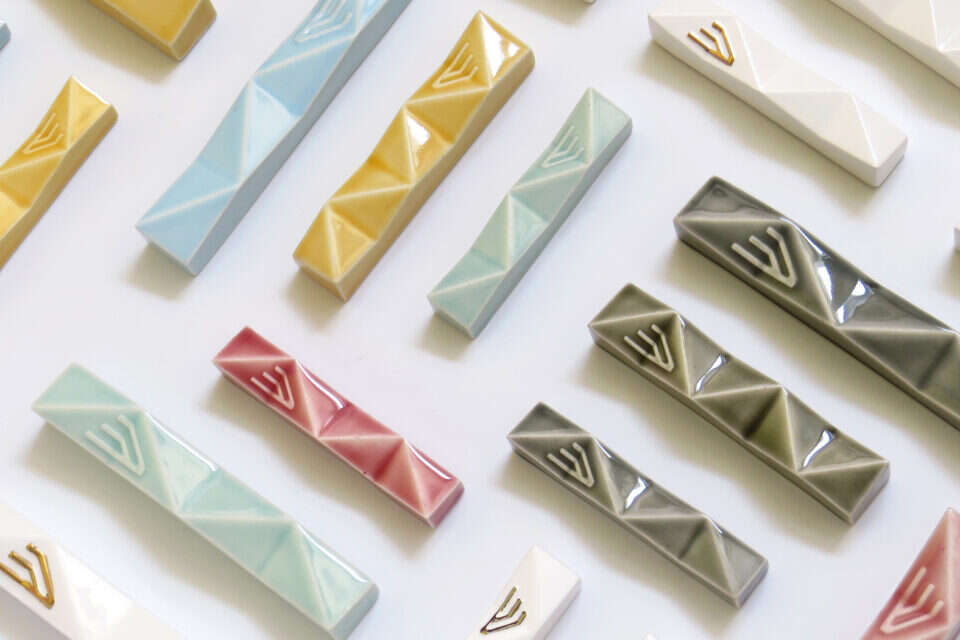It seems that the mezuzah has become a consensus among all Jews wherever they are - secular and religious alike.
The Torah commands us to place a mezuzah at the entrance of the door, and beyond the fact that it is fixed on the right door frame at the entrance to the house, there is something in what the mezuzah represents, a kind of promise of security and protection.
In preparation for Yom Kippur, we chose three mezuzahs, each created from different materials, under different ideas and inspirations, but they all have a common denominator, which is that it is a Judaica item that can be incorporated into the entrance of any home or building.
Alongside the mezuzahs, we also chose a decorative and special glass ball, which gives an original and up-to-date interpretation to the item against the evil eye - a symbol that protects us from evil, and in this case became a designed item, with philosophical meanings much broader than the aesthetic line that defines it.
The connection between faith and art
The multidisciplinary architect and artist Irma Orenstein launched a crystal mezuzah with the LALIQUE design house, one of the leaders in the international design scene.
She thus became the first Israeli to collaborate with the global design house.
The crystal mezuzah that was launched last month in Paris, is part of the fall-winter 22-23 collection of the French design house.
The mezuzah is one of the prominent Jewish motifs, but the virtues attached to it of protection from evil, make it relevant to anyone who wishes to protect himself and his family members, regardless of religion or nationality.
Orenstein created an interesting encounter between faith and art, and emphasized through the mezuzah that shaped this connection and its cross-faith nature.
The crystal mezuzah reveals a silhouette of rounded curves symbolizing a harmonious flow, inspired by the golden sand dunes of the land of camels that Orenstein dreamed of as a child in Russia.
The mezuzah is made of crystal curves and its base comes in silver or pure gold plating.
The collaboration also includes a limited edition of 18 gem-encrusted mezuzahs, developed in collaboration with some of the world's most respected rabbis, which will be offered to synagogues, Jewish communities around the world and art collectors.
The drawings during the development of the mezuzah for Lalik design house, photo: Quentin Valleye - Cyclon'valleye Production
Left: crystal mezuzah with a pure gold base, right: the limited edition inlaid with gemstones on a silver base, photo: Karine Faby
A close-up of a crystal mezuzah from the limited edition designed by Irma Orenstein for the Lalik design house, photo: Karine Faby
The choice of the oligarch
A mezuzah designed and developed by the artist Jacob Merdinger, made of silver and pure gold by hand, from the "Kingdoms" collection, which is considered the most prestigious of the goldsmiths' collections.
The mezuzah was purchased by a Jewish oligarch who is a private art lover, who regularly hosts presidents and heads of state in his home.
For him, the mezuzah completed the look of the rest of the items in the collection which he purchased in full, worth about a million dollars, on the occasion of hosting several presidents from the continent of Africa.
A royal mezuzah made of silver and pure gold designed by the artist Jacob Mardinger.
Purchased by an oligarch who loves art details, the goldsmiths, photo: the goldsmiths
Inspired by the Japanese paper folds
A series of mezuzahs developed and designed by Studio Armadillo, inspired by the Japanese folding of paper - the origami.
The development of the models started with folding paper, translated into 3D files on the computer, and from them molds were made for casting ceramics in a manual process.
The design and production processes combine manual and traditional crafts, with serial and modern production processes.
In 2009, Hadas Kroc and Anat Stein, owners of Studio Armadillo, participated in the Re-inventing Rituals exhibition at the Jewish Museum in New York.
At the exhibition they presented art pieces.
The owner of the museum store who was present at the exhibition liked the design line, and asked to produce a serial item that would be accessible to visitors and sold in the museum store.
Since then, the studio's product line has been expanding, and the mezuzah houses and other items are regularly sold in the Jewish Museum store.
Several years ago, the old JCC building in Washington underwent a comprehensive renovation and preservation, as part of which mezuzah houses of different sizes and colors were purchased for the different wings.
And this year an invitation was also received from the President's house in Israel.
The studio specializes in designing original Judaica items, in a contemporary and minimalist design.
All items are produced in Israel, in small series, by hand, under fair conditions, by craftsmen and artists who are among the best in their field.
White mezuzahs with silver plating, mezuzahs from Studio Armadillo Judaica, photo: PR
A modern look for the traditional mezuzah, a red mezuzah from Studio Armadillo Judaica, photo: PR
A powder shade creates a contemporary look for the traditional item, Studio Armadillo Judaica, photo: PR
between the physical and the metaphysical
A visit to the homeland of the industrial designer Dafi Reiss Doron at the flea market in Jaffa, gave birth to an idea to create an up-to-date version of an object against the evil eye, which can be found in the market on every corner.
The formal concept she chose for the object was a game with the familiar circles, inside a three-dimensional bubble.
To illustrate the metaphysical dimension (abstract, AS) that the object has against the evil eye, the designer chose to use two mirrors installed inside the glass ball, one against the other, to create an effect of infinity. An internal screw made of brass holds the mirrors facing each other. The glass ball can be hung on the wall, so that those who look into it experience a kind of introspection, in the physical and spiritual dimension.
After the completion of the project, Reiss Doron was looking for relevant material to write about in preparation for its presentation, and came across an article by Miriam Blich about the perception of the evil eye in Kabbalah.
The meeting with Blich opened the world of Kabbalah to her and introduced another dimension into her life, which continues to influence her and her work.
With Blich, she also learned about the teachings of the Baal Shem Tov who described our world as a reflection of the subconscious, and evil as depending on each person's inner view of the world.
A glass ball against the evil eye, from Dafi Reis Doron Studio, photo: Hila Marcel Kook
Sketches from the development process, glass ball against the evil eye, from Dafi Reyes Doron Studio
A glass ball in the shape of an eye, in the center of which an internal mirror system is installed, is a mirror against the evil eye, from Dafi Reyes Doron Studio, photo: Hila Marcel Kook
were we wrong
We will fix it!
If you found an error in the article, we would appreciate it if you shared it with us








